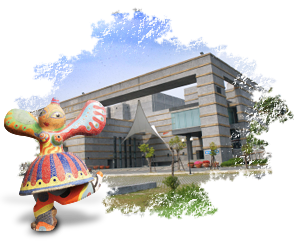Development and History
There were 19 employees in the initial operation stage within the organization of the three sections of museum, promotion and art, all under a director (also the librarian) and a secretary (also the chief of general affairs) who handled and implemented the social, educational and cultural activities based on the library and financially supported by the Council for Cultural Affairs, Executive Yuan and the Education Department, Taiwan Provincial Government. The first director of the Cultural Center of Changhua County was Mr. Lin Hai-Ching.
In cooperation with the Council for Cultural Affairs of Executive Yuan and the Culture Department of the Taiwan Provincial Government to promote the national arts and culture festivals to be locally rooted and the comprehensive community buildings, the Cultural Affairs Bureau has become the main force for promoting local culture since 1994. With the planned construction of the exclusive art performance venues including the Nan Guan and Bei Guan Center and the Yuanlin Performance Hall, and due to the increasing responsibilities of routine business, the original organization of 19 people could not handle the new business and the services that needed to be provided. The plan for the organization’s expansion began at the end of 1993 and took more than four years to be approved by the authorities and county government for an expansion to 46 people in May 1998 with an annual recruitment of nine people for three years from 1999. The new organization was supervised by a director and a secretary and divided into the two sections: general affairs and promotion, three halls: library, gallery and museum, and two units: personnel and accounting.

In August 1999, the Ministry of the Interior enacted and issued the “Criteria for Local Administrative Organizations” in accordance with Paragraphs 1, 2 and 3 of Article 62 of the Law for Local Government Systems. According to Paragraph 2 of Article 3 of the “Criteria for Local Administrative Organizations”, any county or city government shall set up self-government ordinances and related regulations in accordance with this criteria. In accordance with Paragraph 1 of Article 11 of the “Organization of Self-government Ordinance, Changhua County Government”, the “Organization Regulations and Chart of the Cultural Affairs Bureau, Changhua County Government” was enacted by the Cultural Affairs Bureau of Changhua County Government, examined and passed by the county affairs conference, and then sent to the Ministry of Civil Service for approval and reference.
In January 2000, the Cultural Affairs Bureau of Changhua County Government was officially restructured and promoted to be a first-class organization subordinate to the Changhua County Government. With a total of 51 people, the organization was supervised by a director, a deputy director and a secretary and divided into seven sections: library information, cultural assets, arts promotion, visual performance, traditional opera (Nan Guan and Bei Guan Center), Southern Changhua art performances (Yuanlin Performance Hall) and administration, as well as three offices: personnel, accounting and civil service ethics. The Cultural Affairs Bureau of Changhua County Government had the grand opening on March 1, 2000 and Mr. Lee Chun-Te (the former director of the Cultural Center of Changhua County Government) acted as the first director. The Cultural Center, a red building that has erected next to the Baguashan Ceremonial Arch since 1983, was thus transformed into the Cultural Affairs Bureau and soared to great new heights.